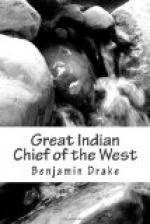Fort Armstrong, was chosen by Major Garland as the most appropriate spot for the ceremonies of the liberation of Black Hawk and his party; as its central position, would enable him to assemble, at a short notice, many Indians from the surrounding villages. This was the favorite island of the Indians; in former years abundant in fruits and flowers; and, from time immemorial the fancied abode of a good Spirit, which watched over their village, and protected their hunting grounds. No spot could have been selected, calculated to awaken so many painful associations in the mind of Black Hawk, as Rock Island. For half a century it had been the witness of his power and influence; it was now to become the scene of his disgrace, and reluctant submission to a rival.
[Illustration: TREATY AT FORT ARMSTRONG.]
Immediately after Major Garland’s arrival at Fort Armstrong, he sent out runners for the purpose of assembling the neighboring Indians. The messenger despatched for Keokuk and his chiefs, found them encamped about twenty miles below the island, having just returned from a buffalo hunt, and being on their way to fort Armstrong, in expectation of meeting the returning captives. The runner returned that night, and reported to Major Garland, that on the morrow, Keokuk with a party of braves would reach Rock Island. About noon, on the following day, the sound of the Indian drum, and the shouts and wild songs of his people, announced the approach of the princely Keokuk. He ascended the Mississippi by water, and led the van with two large canoes, lashed side by side, handsomely decorated, with a canopy erected over them, beneath which sat the chief and his three wives, with the American flag waving over them. More than twenty canoes followed the chieftain, each containing from four to eight of his warriors, whose shouts and songs, swept over the transparent waters of the Mississippi, and were echoed from shore to shore. This fleet of canoes, was rowed slowly up the stream, until it passed the camp of the captives; it then returned and the party landed on the bank of the river, opposite to the camp of Black Hawk. Here Keokuk and his party spent several hours in arranging their dress, painting their faces and equipping themselves with their implements of war. This duty of the toilet being finished, they returned to their canoes, resumed their songs, and proceeded directly across the river. Keokuk, very elegantly dressed, decorated with his medals and fully armed, was the first to land, and turning to his followers, said, “The Great Spirit has sent our brother back. Let us shake hands with him in friendship.” He then proceeded slowly, followed by his warriors, towards Black Hawk, who was seated, with his party, in front of his temporary lodge, leaning upon his staff, and deeply affected by the occasion. Keokuk kindly extended his hand to him, which the old man took with some cordiality. Having saluted the rest of the captives, he took a




